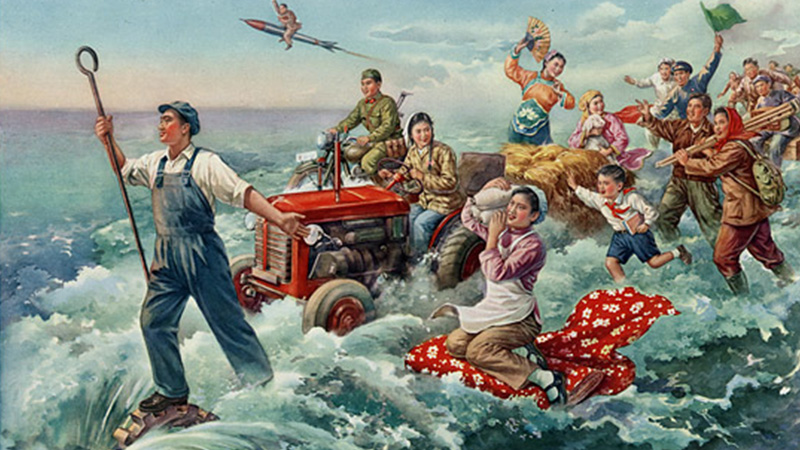Advances in Technology and Exchange after 1900
Teacher Resources
Driving Question: In what ways has technological innovation helped solve global challenges, and what new challenges has it created?
In the last 250 years, the rapid pace of change and increasingly global interconnections have produced an era of intensive globalization. Humanity produces more stuff, more cheaply, and distributes it all more broadly than ever. Yet, these trends haven’t benefited everyone everywhere, and distribution of the stuff produced remains unequal. We are more connected by networks than ever before, but many people feel more isolated and lonelier. How is this era of intensive globalization a product of our long human history, and where will we go in the future?
Learning Objectives
- Understand how historians create narratives to explain the convergence and divergence of human communities and experiences during this era.
- Explain how the development of new technologies changed the world from 1900 to the present.
Vocab Terms:
- biodiversity
- gross domestic product (GDP)
- microplastic
- monoculture
- multinational
- pesticide
- privatize
Opener: Advances in Technology and Exchange
To teach this lesson step, refer to page 2 of the Lesson 9.1 Teaching Guide.
Our Openers and Closers Guide provides information about these short, but important activities at the start and end of each lesson.
How much has change accelerated from 1945 to the present? You might be surprised.
Globalization I – The Upside: Crash Course World History #41
To teach this lesson step, refer to page 3 of the Lesson 9.1 Teaching Guide.
The OER Project Video Guide includes best practices for using video in the classroom.
John Green walks you through what globalization looks like—and how t-shirts are made—in the twenty-first century. How has this system of globalized production improved our lives? How has it endangered us?
-
Guiding Questions
-
Before you watch
Preview the questions below, and then review the transcript.
While you watch
Look for answers to these questions:
- How does John Green define globalization?
- What are some factors that John Green points to in order to explain why the scale of global trade has increased?
- What does John Green list as some of the advantages of globalization?
- How does John Green say your t-shirt is an indication of how globalization has made your life better?
- John Green mentions some of the radical changes brought by globalization. What are they?
After you watch
Respond to the following question:
- Do you think the advantages of globalization are “worth it”? How might your answer change if you lived somewhere else or in different circumstances?
Key Ideas
Advances in Technology and Exchange after 1900
To teach this lesson step, refer to page 4 of the Lesson 9.1 Teaching Guide.
Can you imagine a world without cell phones, air travel, and antibiotics? You wouldn’t have to go too far back in time to witness a world without these advancements.
-
Guiding Questions
-
Before you read
Preview the questions below, and then skim the article. Be sure to look at the section headings and any images.
While you read
Look for answers to these questions:
- When was plastic invented and when did it become more popular? How is that same plastic still impacting our world today?
- How did new energy sources transform the world in the twentieth century?
- How have communication and transportation changed since 1900?
- How did new agricultural and medical technologies transform people’s lives?
- What are some of the limitations of these advancements in technology?
After you read
Respond to these questions:
- How can some of the negative impacts of technology be mitigated?
- How did new technologies change the world from 1900 to the present?
Green Revolution
To teach this lesson step, refer to page 4 of the Lesson 9.1 Teaching Guide.
As with many revolutions, the changes created by the Green Revolution did not impact everyone equally. Explore the aims, political motivations, and results of the Green Revolution in this video.
-
Guiding Questions
-
Before you watch
Preview the questions below, and then review the transcript.
While you watch
Look for answers to these questions:
- Why did the US State Department official William Gaud coin the term “Green Revolution” in 1968, and what was he contrasting it to?
- Eman M. Elshaikh refers to a common saying in the US State Department in the Cold War: “Where hunger goes, communism follows.” What does this mean, and how did this concern help launch the Green Revolution?
- How did the Green Revolution differ in different regions and what were its results?
- What were some of the methods and results of the Green Revolution?
- What are some of the critiques of the Green Revolution?
After you watch
Respond to the following questions:
- Why is it important to include the Green Revolution when considering the extent to which new global connections and innovations brought changes in different parts of the world from c. 1900 to today?
- There is still ongoing debate about the policies and the legacy of the Green Revolution, and its legacy is still evident today. Based on the video and your understanding of geopolitics in the Cold War and today, how do you think we can best measure whether it was a success?
Key Ideas
Closer: Advances in Technology and Exchange
To teach this lesson step, refer to page 6 of the Lesson 9.1 Teaching Guide.
You’ve “traveled” quite a long way during this lesson. Time to use your imagination as you look back on how much has changed.


